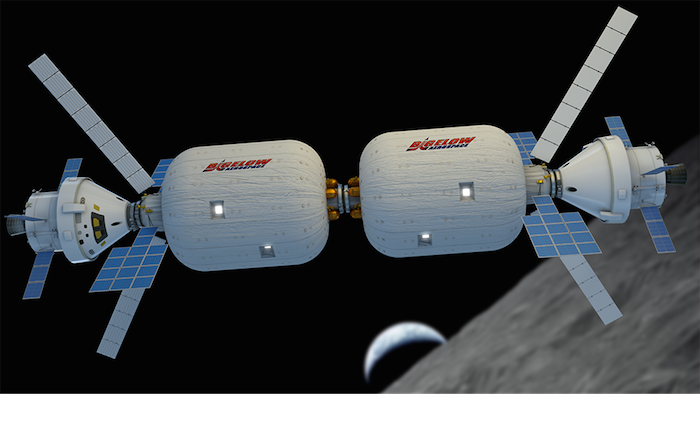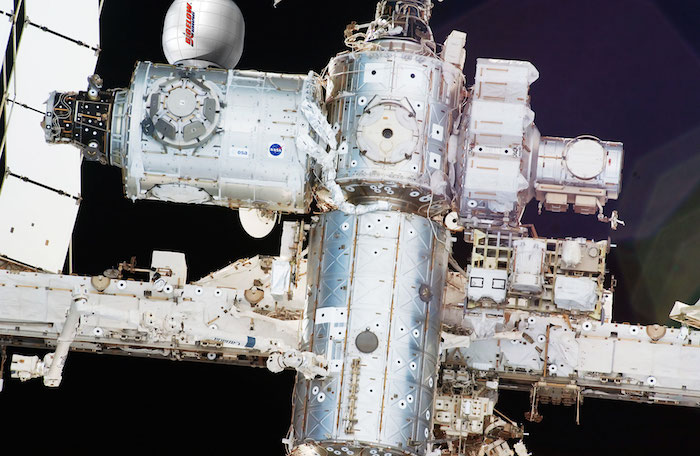.


----
Bigelow Aerospace and NASA
Execute NextSTEP Contract to Study B330 Utilization
NASA has executed a contract with Bigelow Aerospace for the company to develop ambitious human spaceflight missions that leverage its innovative B330 space habitat. The contract was executed under the Next Space Technologies for Exploration Partnerships (“NextSTEP”) Broad Agency Announcement issued by NASA’s Advanced Exploration Systems program.
Via its NextSTEP contract, Bigelow Aerospace will demonstrate to NASA how B330 habitats can be used to support safe, affordable, and robust human spaceflight missions to the Moon, Mars, and beyond. As the name indicates, the B330 will provide 330 cubic meters of internal volume and each habitat can support a crew of up to six. Bigelow expandable habitats provide much greater volume than metallic structures, as well as enhanced protection against radiation and physical debris. Moreover, Bigelow habitats are lighter and take up substantially less rocket fairing space, and are far more affordable than traditional, rigid modules. These advantages make the B330 the ideal habitat to implement NASA’s beyond low Earth orbit (“LEO”) plans and will support the utilization of transportation systems such as the SLS and Orion. Additionally, the B330s, which will initially be deployed and tested in LEO, will be used as private sector space stations that will conduct a wide variety of commercial activities.
“We’re eager to work with NASA to show how B330s can support historic human spaceflight missions to the Moon and other destinations in cislunar space while still staying within the bounds of the Agency’s existing budget,” said Bigelow Aerospace’s President and founder, Robert T. Bigelow. “NASA originally conceived of expandable habitats decades ago to perform beyond LEO missions, and we at Bigelow Aerospace look forward to finally bringing that vision to fruition.”
.

The Bigelow Expandable Activity Module (BEAM)
NASA Deputy Administrator Lori Garver announced a newly planned addition to the International Space Station that will use the orbiting laboratory to test expandable space habitat technology. NASA has awarded a $17.8 million contract to Bigelow Aerospace to provide a Bigelow Expandable Activity Module (BEAM), which is scheduled to arrive at the space station in 2015 for a two-year technology demonstration. The BEAM is scheduled to launch aboard the eighth SpaceX cargo resupply mission to the station contracted by NASA, currently planned for 2015.
After the module is berthed to the station's Tranquility node, the station crew will activate a pressurization system to expand the structure to its full size using air stored within the packed module. Astronauts periodically will enter the module to gather performance data and perform inspections. Following the test period, the module will be jettisoned from the station, burning up on re-entry.
SpaceX CRS-8, also known as SpX-8, is a spaceflight cargo resupply mission to the International Space Station scheduled for 2015. The mission has been contracted by NASA and will be flown by SpaceX.
FIRST EXPANDABLE HABITAT TO THE INTERNATIONAL SPACE STATION
"Today we're demonstrating progress on a technology that will advance important long-duration human spaceflight goals," Garver said. "NASA's partnership with Bigelow opens a new chapter in our continuing work to bring the innovation of industry to space, heralding cutting-edge technology that can allow humans to thrive in space safely and affordably." - NASA Deputy Administrator Lori Garver
.

Quelle: BIGELOW
4632 Views
